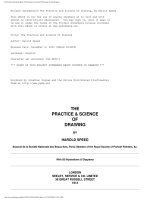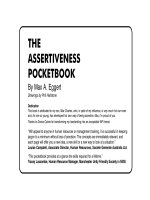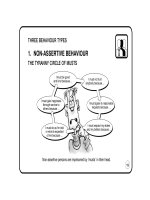THE BALANCE SHEET POCKET BOOK phần 1 pps
Bạn đang xem bản rút gọn của tài liệu. Xem và tải ngay bản đầy đủ của tài liệu tại đây (126.79 KB, 10 trang )
THE
BALANCE SHEET
POCKETBOOK
By Anne Hawkins and Clive Turner
Drawings by Phil Hailstone
“A uniquely accessible guide - if you only read one book on finance, read this!”
Peter Colley, Director of Finance and Membership Services,
RAC Motoring Services Ltd
“The authors’ wealth of practical experience and understanding of the line
manager’s perspective is fully reflected in this clear and readable book.”
Ray Jennings, Human Resources Director, Dowty Aerospace
CONTENTS
INTRODUCTION 1
THE BUSINESS 5
FINANCIAL MODEL
Sources of Funds, Uses of
Funds, making profit, summary
CLASSIFICATION 35
OF EXPENDITURE
Why classify? Capital or
Revenue? control
FINANCIAL REPORTS 41
Introduction
THE BALANCE SHEET 45
Use of Funds (Fixed Assets,
Working Capital), Source of Funds,
the balancing act, published format
PROFIT AND LOSS ACCOUNT 69
Profit is not cash, operating profit,
financing costs, published format
APPENDIX ONE 93
Jargon explained
APPENDIX TWO 101
Calculating depreciation
This symbol refers the reader back to a
previous section where the item or term
has already been explained
2
NB
INTRODUCTION
1
INTRODUCTION
CONFUSED?
Many people are discouraged in their attempts to understand financial statements
by the jargon accountants use and a fear of numbers!
2
Capital Employed
Earnings
Fixed Assets
Creditors
Debtors
Depreciation
Working Capital
Reserves
INTRODUCTION
DON’T BE PUT OFF!
Use the Structured process:
Step One: Develop a ‘common sense’ model of business finance
Step Two: Understand the impact of capital and revenue expenditure on this
Business Financial Model
Step Three: Extract from this Model the
- Balance Sheet
- Profit and Loss Account
3
INTRODUCTION
COMMON MISCONCEPTIONS
Listed below are some of the more common misconceptions we, the authors,
encounter in our training sessions. See if any of them seem familiar
◆ ‘The Balance Sheet tells me the value of the business’
◆ ‘At the year-end the retained profit must be somewhere; in the bank,
or the accountant’s drawer’
◆ ‘If the company’s share price rises it has more money’
◆ ‘If I compare the results of two businesses, the one which has made more
profit has done better’
◆ ‘The accountant balances the Balance Sheet by entering a balancing
figure somewhere probably profit’
These misconceptions will be dealt with at appropriate points in the book.
4
THE BUSINESS FINANCIAL MODEL
Page
Introduction 6
Source of Funds 9
Uses of Funds 18
Making Profit 28
Summary 31
5
2
THE BUSINESS FINANCIAL MODEL
INTRODUCTION
In this section a Business Model is developed which explains in straightforward
terms how money works within the business.
6
2
THE BUSINESS FINANCIAL MODEL
THE MODEL
7
2
SOURCE OF FUNDS
USE OF FUNDS
SHARE CAPITAL LOAN CAPITAL RETAINED PROFITS
PRODUCTS / SERVICES
WORKING CAPITAL
Sales
Attributable Cost
Operating Profit
Interest
Tax
Earnings
Dividend
Retained Profits
Less:
Less:
Less:
Depreciation
FACILITIES / PROCESSES
FIXED ASSETS
THE BUSINESS FINANCIAL MODEL
APPLYING THE MODEL
Use the model to understand your business
● How is your business funded?
● What have you used this money for?
● How much profit do you make?
● IS IT WORTH THE EFFORT?
Make the Business Model and Financial Reports work for you!
Let’s start at the beginning
8
2









